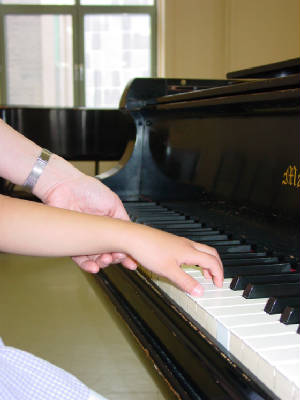|
|
Piano studio - Jeanette Wong
What is the Suzuki Approach? The Suzuki apporach was developed by Dr. Shinichi Suzuki more than 50 years ago. Based on the Mother Tongue Method,
Dr. Suzuki believed that children are capable of developing their musical abilities in the same way they develop their linguistic
abilities.
Some of the basic principles and ingredients of the Suzuki approach are:
1. Begin as Early as Possible. Dr. Suzuki recommends that ability development begin at birth. Formal training with an instrument may be started at age three. 2. Develop the Home Environment. Daily listening to recordings of the Suzuki repertoire, as well as good music in general. A musical home environment develops musical sensitivity in the student. The more the student listens to the CDs, the more quickly he/she learns. This approach derives from the way all normal children learn to speak their native language. 3. Move in Small Steps. This allows the student to master the material with a total sense of success, thereby building confidence and enthusiasm for learning. Each child progresses at his/her own pace. 4. Mother or Father Attends All Lessons and works with the student at home. The parent is the child's most influential helper - providing constant encouragement and motivation. The parent ensures daily listening to the repertoire. The parent learns the fundamentals of playing the instrument in order to facilitate the home practice; the parent acquires basic music reading skills as they apply to the piano. 5. Create an Enjoyable Learning Environment in lessons and home practice. This allows much of the child's motivation to come from enthusiasm for learning and desire to please. With praise and positive reinforcement from teacher and parent, the student continues to advance in an atmosphere of enjoyment and understanding. 6. Group Lesson are valuable aids to motivation, in addition to private lessons and observation of other students' lessons. Children love to do what they see other children do. 7. Foster an Attitude of Cooperation, not competition, among students - of supportiveness for each other's accomplishments. 8. Begin Music Reading only when the child's aural and insturmental skills are well established, just as we teach children to read a language only after they speak. This enables the main focus of the teacher's and student's attention to be on tonalization. Beautiful tone and musical phrasing then become the basic part of the student's earliest training. 9. Follow the Suzuki Repertoire Sequence. Each piece is a building block for the student's careful development. Equally important is the strong motivation this standardized repertoire provides; students want to play what they hear other students play. Constant repetition of the old pieces in a student's repertoire is the secret of the performance ability of Suzuki students.
|
||||||||||
|
|
||||||||||

